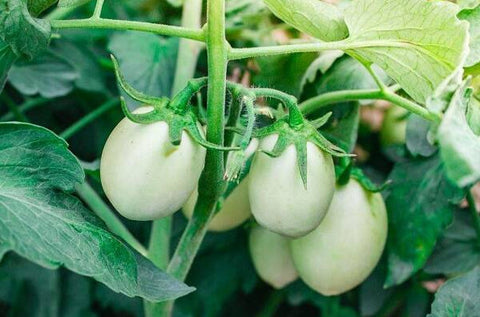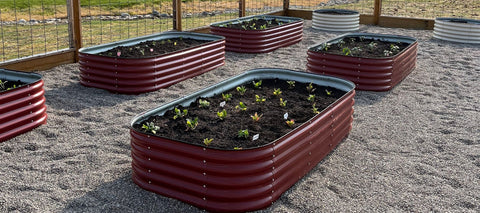Knowledge from Olle Garden beds: Enhancing Your Garden Beds Year after Year
When you planting plants in the Garden beds, crop rotation is a fundamental practice that seasoned gardeners highly recommend, especially for those looking to sustain long-term vegetable gardens. It is a process employed by advanced gardeners to maximize the efficiency of soil utilization.
In essence, crop rotation involves rotating certain crops each year based on their nutrient consumption patterns. Different types of plants have varying effects on the soil. Some are considered light feeders, while others are heavy feeders, and some even contribute to soil-building.
By planting different types of crops in specific areas of your garden beds and rotating them annually, you can effectively optimize the nutrient content of the soil. Crop rotation helps prevent soil depletion over time and mitigates potential damages caused by continuous planting of the same crop.

Embracing Companion Planting
Companion planting refers to the practice of placing certain plants in closer proximity to enhance the overall quality of each plant.
Companion planting assists in controlling pest populations, improving soil fertility, providing natural shade, weed control, and even managing the amount of shade from taller plants. A more comprehensive guide on companion planting can be found on Garden beds, offering you long-term benefits for your garden.
Label your Plants While Planting
Many beginners struggle with garden organization as they often forget what they've planted and where. Seasoned gardeners have found that labeling their plants during the planting process helps to avoid confusion and maintain overall garden organization. While it may seem unnecessary at first, you'll soon realize how easily forgotten it can be. Forgetting what's planted where may result in the need to dig up seeds again, causing unnecessary time waste. So, remember to label your plants with something simple stuck into the ground, like a plant tag.
Having the Right Gardening Tools
When you embark on your gardening journey, ensuring that you have the appropriate tools for your gardening process is essential. Having the right tools can make gardening more efficient and manageable. Crucial tools include waterproof and breathable gloves, shovels, pruners, hoes, a wheelbarrow, and a hand rake.
Using a Hose with Nozzle Attachment
In addition to the basic gardening tools, you should also make sure you have a reliable water source. Specifically, a hose with a nozzle attachment is essential. This attachment allows water to be delivered to specific areas of the garden with various spray settings, ensuring water reaches particular parts of the garden under the right pressure arrangement.
Water Your Garden at the Right Time
Watering your garden isn't just about giving it water, but also about ensuring you water it at the right time of the day. Generally, the best time to water your garden beds is before the sun hits it directly, as the soil has the capacity to absorb water before the sun's heat and energy evaporate it. Additionally, you should provide deep watering once or twice a week, ensuring you meet each plant's specific water needs.

Clearing Out Weeds
Removing weeds from your garden beds as they grow is a must. Many people have the misconception that letting weeds grow will benefit their crops. However, they fail to consider that weeds are also plants that absorb many nutrients from the soil. While plants can utilize nutrients to a limited extent, weeds will eventually steal away all the nutrients from the soil, occupying precious garden space. Therefore, make sure to clear out weeds as they grow to ensure your crops thrive.
Eliminating Deadheads on Certain Plants
Another mistake many beginners make is leaving deadheads on their crops. These withered flowers not only look unsightly but also hinder the growth of new flowers. To facilitate new flower growth and encourage vegetable production, you can remove the dead parts of the plants.
However, you shouldn't do this just any way. Typically, you should pinch them off with your fingers or use pruning shears. This video can further guide you on the proper method of deadheading.
Attracting Mason Bees to the Area
Bees can significantly improve the health of your garden beds by pollinating flowers and promoting their growth. Consequently, you can improve your garden by attracting mason bees. There are various methods you can employ to achieve this.
You'll want to disperse some bee food and provide a quality mud source around the bee house. Bee houses are essentially made of wood with small holes inside for the bees. Ecolandscaping.org offers more detailed information on attracting mason bees.
Proper Seed Storage
Especially for those planning to garden annually, you can make the most of your gardening process by correctly storing seeds from certain plants after harvest. If stored correctly, you can use them in the future to grow more crops. To store them properly, you need to place them in a closed container, in a place with constant temperature and humidity.
Transplant When Necessary
Finally, you'll want to start most of your plants in your garden beds from seeds. However, for plants that take longer to mature, you may benefit from transplanting some of your crops. If done right, you can save yourself time and effort.

Use a Gardening Journal
Lastly, it's highly recommended that you create and use a gardening journal to document your gardening process. It helps you keep all tracking information in one place, making it easy to see your progress over the years. You can track what crops you've planted, where you planted them, and how they progress. You can even include pictures in the journal to document your garden's development more accurately. Ultimately, using a gardening journal can help you become a more productive gardener.
In conclusion, tending to your Garden beds can be a daunting
